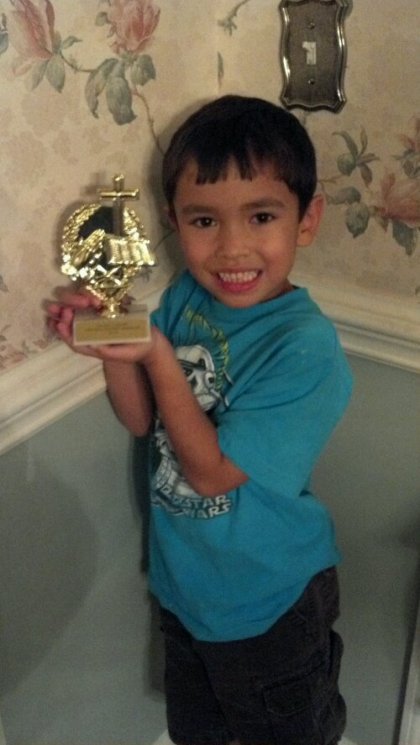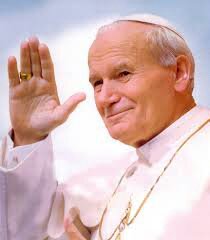Filed under: Uncategorized
I have finally made the move to my own domain. Please visit http://www.littlewayofthefamily.com. I have already migrated the entire blog archives, and I have sent in a request to have all followers transferred. This should happen in the next few days. Shortly I will set up a redirect from the old site to the new.
Why did I decide to make the switch? First and foremost, I will soon be publishing my first novel, and I want to be able to sell it on this site. That would be impossible with the old site. Second, I have future customization ideas that would be impossible on the wordpress.com site. Finally, I just really like the shorter domain name!
Anyway, thanks for visiting and “listening” to what I have to say. Please follow me over to Little Way of the Family!
Filed under: Children, Culture, Daily Life, Passing on the Faith | Tags: child rearing, children, Faith, kids, morals, parenting, teens, video games
If you needed more reasons to keep violent video games out of your home, here it is. New research shows a clear connection between playing violent video games and a lack of moral development in teens.
What struck me most about this particular article was not the confirmation of the obvious – that video games are bad for kids – but one throwaway comment by the author of the study.
Bajovic concedes that “prohibiting adolescents from playing violent video games is not realistic.”
The notion that it’s unrealistic for parents to prohibit destructive behavior in their teens is self-evident to a Science Daily journalist and accepted by a researcher in teen behavior. It’s a pretty common delusion. I know parents of 2nd graders who can’t say no when their kids ask for a smartphone. I have had other parents tell me to just send my kids to public school. You can’t keep them from being exposed to that stuff anyway, right?
It’s so wrong-headed it makes me want to hit my head against the wall. Our kids don’t have to play video games. They don’t have to be sexually active. They don’t have to try alcohol as a minor.
As parents, we must have a firm loving hand. We need to show strong moral leadership. We have to keep them away from bad influences and surround them with positive.
It’s a ton of work, it requires sacrifice, and there are no guarantees. Our children are humans with free will, after all. But that doesn’t mean it’s useless to try. Car seats and seat belts aren’t guaranteed either, but we’d never consider not using them.
Be strong and protect your kids while you can. They’ll enter the big bad world soon enough.
Filed under: Culture, Daily Life, Marriage | Tags: dreams, Family, goals, new years resolutions, personal improvement, planning, self-help
Litany of Broken Resolutions
I used to make New Year’s Resolutions. The same ones year after year. They were always broken, usually by mid-January.
The problem is that New Year’s Resolutions typically are little more than good intentions and wishful thinking. Neither gets you anywhere except frustrated and disappointed. But every year we keep trying. We keep telling ourselves that this is the year we will keep that diet, stick to that exercise regimen, or drop that bad habit for good.
Then one day my lovely and intelligent MBA wife introduced me to the concept of strategic planning and proceeded to apply that concept to our family life. With that strategic plan we are able to make substantive long-term changes (for the better!) to our family life. And it’s not at all hard to do.
Writing Your Family Strategic Plan
What is a strategic plan? It is a method of figuring out what you want to accomplish, why you want to accomplish it, and how you are going to accomplish it. You start out at the highest level with the big “why”, the mission statement. Then you write down a vision for the future. Then you break down specific objectives designed to meet that vision. Then you write down steps, or goals, that will help you to achieve those objectives. Does that sound hard? If so, lets take it step by step.
The Mission Statement
Most businesses have mission statements. These represent the business’s raison d’etre, its reason for being. Usually it is something that seems, from the outside, to be either self-evident or rather meaningless. Something like “To meet the needs of our customer’s and employees with integrity and excellence”, but perhaps with more specifics.
But it’s not meaningless. It is a yardstick by which any action can be measured. The business decision makers can determine if any particular action furthers the mission, works against it, or is a distraction from it. It helps keep the focus.
A family needs a mission statement too. What is the purpose of your family? Why did God put your family here on earth? It is not an easy question to answer.
It took us quite a conversation to write our first mission statement, and it evolved over the first couple of years, especially as our faith matured. But we now have a mission statement that accurately reflects our family and that I believe will do so for years to come. Here it is:
To be witnesses of Jesus Christ within our family, in our community, and throughout the world.
Simple, isn’t it? It wasn’t when we started. It took awhile to distill our mission into what is, on the face, rather simplistic. That process, however, told us so much about our family life, and it gave us a renewed focus and determination toward simplicity of life. Hopefully your mission statement will be just as succinct and just as meaningful to you.
The Vision
Where do you want to be? Who do you want to be? What do you want to accomplish? This is your vision.
Take some time to discuss with your spouse where you see your family in a year. In five years. Perhaps you want to move closer to extended family. Perhaps you want to get out of debt. Perhaps you want a reinvigorated faith life. Perhaps you want a stronger marriage, or more children. If you see yourself exactly as you are now, that is a perfectly wonderful thing.
Be specific. If you want an employment change, what kind of employment do you desire? If you want to move, where? If you need a bigger house, how big?
This should be a fun and enriching activity for a couple. You likely shared your dreams of the future when you were engaged or first married, but for many, those conversations get overwhelmed by the day-to-day effort of living. So take your time, and enjoy it. Remember to make separate vision statements for one year out and for five years out. Here are some questions that might guide you. (I am presuming you are married.)
How many children will you have?
Where will you live?
Will you and/or your spouse be working? In what field? At what job?
What will your relationship be like with your extended family – parents, in-laws, etc?
What will youu faith life be like?
What kind of lifestyle will you be living?
What will your kids be doing?
Is there some sort of vocation that you wish to be engaged in?
Are there any major changes to your life you desire or foresee?
You can write it any way you like, in a list format or a narrative paragraph or some other way. Try to keep it realistic, but don’t be afraid to be ambitious. Try to avoid materialism. Remember that this vision will represent the kind of person you will be. If your vision is focussed on money, so will you be.
Now that you have a one year and a five year vision, start thinking about how you are going to get there and what you need to accomplish this year to make that vision a reality. But to do that, you need to break it down into pieces you can get your arms around.
What are the important parts of your life? Each of these will have an Objective.
The key areas of my family’s life are:
1. God and Faith
2. Marriage
3. Children
4. Careers
5. Education (both children and parents)
6. Recreation
7. Health and Wellness
8. Finances
9. Household
10. Community Service/Charity
11. Extended Family
12. Time Management
7. Finances
8. Recreation
Setting an Objective
Each area gets an objective. This objective is a little bit like a mission statement for that part of our life, its guiding principle. Just like the mission statement, it should be succinct and should accurately reflect your most cherished values. And just like the mission statement, it should not change from year to year, once you really have it nailed down. For instance, our objective for our children is:
“Build a legacy of faith through the generations.”
Pretty simple, but everything we do for our children leads back to that one statement.
Now to the meat of it. Here is where you lay out the specific things you are going to do to meet the above objectives and to reach the vision you set out for yourself.
These will include steps to take daily, weekly, or monthly, as well as one time goals, possibly with a due date attached. For instance, in the above example, we have a goal to keep our kids in Catholic school. We also have a goal to maintain family faith-based rituals to strengthen their faith. We also have specific goals for extracurricular activities that will strengthen their character and self-discipline as well as let them make the best possible use of their God-given talents. One goal is to involve the children in weekly service projects. Another is to ensure that each child is taking lessons on a musical instrument.
Don’t put steps here that are vague. Saying “eat less” won’t get you anywhere. Steps here should be of the type where you can say, with no uncertainty, whether or not it was accomplished or at least whether progress toward it is being made. If you don’t yet know exactly what to do but have a general idea, put in a planning task such as “create meal plan”. This plan would then be a supplement to the strategic plan.
Finally, these steps should be realistic. Don’t make commitments you are pretty sure you won’t be able to meet. Therein lies frustration. You may find you need to adjust your one-year or five-year vision if the steps you need to take aren’t do-able. Perhaps scale the vision back and make your one-year vision a little more intermediate.
Following Through
No plan is worth the effort if it isn’t carried out. There are several necessary steps toward following through.
1. Log both the specific dates and the recurring tasks on your calendar.
2. Review your calendar (as a couple) daily, weekly, and monthly.
3. Review the strategic plan (as a couple) once a month.
4. If you are straying from the plan, consider revising it to either make the goals more realistic, eliminate items that have become moot or obsolete or add steps to remove roadblocks.
5. Reward yourself when you have accomplished one of the more difficult steps.
Don’t get discouraged if you fall behind in any particular area. This is a plan, not a “resolution”. You work toward the plan until you complete it, even if it takes longer than you originally thought. And don’t be afraid to decide that you were wrong, that one or more of the objectives you wrote down wasn’t really what God had in mind for you. Part of this whole activity is a process of discernment, giving you a framework on which you can struggle to find out just what it is that God wants of you in the here and now.
New Years doesn’t have to be a time for false promises or the cultivation of future disappointments. It can be a catalyst for real change, and a Family Strategic Plan can be a road map to that change.
Filed under: Culture, Daily Life, Feasts, Memorials, and Solemnities, Passing on the Faith, The Holy Family | Tags: catholic, Christ, family life, Fatherhood, Holy Family, humility
One of the virtues of the Holy Family that I try to emulate is humility. It’s a challenging virtue, and easy to forget in this competitive, success-oriented world.
It’s so easy, in the day-to-day effort to grow in holiness, to become judgemental and preachy, especially toward those who don’t seem to share my values. “I can’t believe she dresses like that for Mass.” “Their children are completely out of control. They probably let them watch too much television.” “You can tell they’re using contraception. Otherwise they’d have had another child by now.” “I’m just glad we’re not like that.”
It plays out in the abortion debate too, with some pro-lifers more focussed on condemning than saving, overwhelmed by their anger at the injustice of it all.
We all do this, to one extent or another. It’s in our nature, and it’s certainly an integral part of our culture. We like nothing more than holding up others’ faults to make us feel better about ourselves.
The thing is, we may very well be “correct” in our assessment of others. The young woman may be dressed inappropriately for Mass. The family may be letting too much culture rot into their home, with the resulting influence evident in their kids’ behavior. The couple may be using contraception. But self-righteously pointing that out – and basking in the pride that we aren’t like them – will win no converts and help no one get into heaven.
What that will lead to is our own humiliation. For when we sin – and we will – others will see that as a confirmation that we were full of hot air. That all that talk of holiness was just another attempt to one-up the next guy. That it was all a lie. And we will be like the television evangelist caught in adultery or theft or some other scandal. Just another holy roller with skeletons in our closet.
Instead, we have be aware of our own sin (the log in our own eye). And we have to publicly acknowledge it’s presence and our need to overcome. We have to be little in our own eyes, and our words and actions should acknowledge that littleness. Then we can become an example to others of following the path to holiness. Then any good actions we do point to Jesus and not to ourselves.
The Holy Family – Joseph, Mary, and Jesus – is a perfect example of this humility. Mary did not go around preaching to the other mothers in Nazareth, pointing out their faults, making sure they knew that God had chosen her to be His mother and not them. Joseph did not try to become the next great rabbi or get followers of his own. Instead they tried to obey God’s will the best they could. They suffered the humiliation and scandal of a pre-marital pregnancy. They lived the life of a simple carpenter’s family, all the while keeping knowledge that would change the world held close in their hearts. They knew their limitations, that all the good that was to come would come from God and not from them.
As parents, this humility is doubly important. Our kids know our faults. We can’t hide them. If we aren’t genuinely humble, our kids will think (and possibly rightly so) that all our “religion talk” is simply a way for us to control and manipulate their behavior. I think that a lack of parental humility is one of the quickest ways to ensure that a child leaves the faith as an adult. During those difficult, rebellious teenage years, they will be quick to jump on any hypocrisy, any “do as I say, not as I do.”
If I tell them not to drink but put down four beers every night after dinner, they will find no reason to avoid drinking when they have an opportunity. If I tell them to be pure and then they find pornography in my internet history, they will decide that porn must really be ok. If I tell them not to lie then brag about cheating on my taxes, lying and cheating will become second nature to them. If I tell them they better love Jesus but they see no love for Jesus in my actions, they will put Jesus in the box with Santa and the Easter Bunny and walk away forever.
If, however, I tell my children that I am weak. That I make mistakes. That I am a sinful man just as St. Peter was. If I tell them these things and say that with God, however, I am working to overcome those weaknesses and that He is making me a better man. Then they will see the reality of the journey that I am on and the journey that God is calling them to. Hopefully they will decide that is a journey that they want to take.
I wrote this post for the Feast of the Holy Family, which was this past Sunday. Obviously, I didn’t finish it in time. Just another example of where I don’t quite measure up to where I want to be. And that’s ok. If I was perfect, I wouldn’t be here, I suppose.
Filed under: Advent, Children, Culture, Daily Life, Family Time | Tags: Advent, Faith, Family, illness
Hard to believe there are two purple candles already burning on my kitchen table. Hard to believe that Thanksgiving has passed and the leftover turkey is a pleasant memory. Hard to believe I haven’t posted since October.
It is a time for reflection and preparation. Our Lord has given me opportunities for reflection that I would rather He hadn’t: health issues kept us busy throughout the month of November. Kept me from blogging. Put us way behind on our decorations. (Yes, that’s important!)
It has put me in a reflective mood, though. The little worlds we build up for ourselves can come crashing down so easily. When we treasure the wrong things, we are crushed when we lose them.
In this life, nothing is more important than faith. In this world, nothing is more important than family. Sure we treasure those things in our thoughts and promises and declarations. But what about our actions? Do we treasure them in our actions? Or are we dismissive and impatient? Do we neglect, thinking that God and family will always be there, but this TV show/game/work opportunity will be lost if I don’t act now?
Treasure every little grace from God. Treasure every moment with your family. That is the best way I know to keep the oil in the lamp, ready for Him to come.
Filed under: Culture, Devotions, Feasts, Memorials, and Solemnities, John Paul II, Theology of the Body | Tags: Canonization, catholic, christian, John Paul II, saint
I am thinking today of our former Holy Father on his memorial. He was an inspiration to me as I converted. Earlier I described my conversion story, but what I didn’t mention then was that during my “searching” period in Italy, I actually saw Pope John Paul II. I was on one of my weekend jaunts to Rome, when I happened upon a very large crowd in St. Peter’s Square. After a bit I figured out that the Pope was speaking right there in the square! I couldn’t get close – he was barely a white speck to me – but he was a discernable white speck, even in the 35mm photograph I took and still have today.
To many in the world, I fear that John Paul II was just another historical figure, akin to a politician, one of those characters of the cold war who are only interesting because of the times they lived in. I fear they think the Church is canonizing him just because he was Pope, and that maybe they canonize anybody that was Pope. He was so much more.
He was a teacher. His books are marvelously accessible, and he broke such important theological ground, both in his work as a bishop and cardinal, particularly with respect to Vatican II, and as the Holy Father. He gave us a much more profound understanding of human sexuality, of our roles as male and female, and especially of the family.
He was a hero. This is a man who became a priest durin the Nazi occupation of Poland, a bishop during the communist regime. He risked his life on a daily basis to bring the faith to others. And once he had the world stage, he made the boldest statement of all. He could have stayed safely in the Vatican, out of controversy and out of harms way. But he went to Poland – almost forced himself there against the wishes of the communists. And he took them to task on their own turf. He gave the people of Poland – and the people of all Eastern Europe – a voice, and he was one of the great catalysts for the miraculous changes that seemed to take place overnight.
He was a Saint, no doubt about it. He met with and forgave the man who tried, and almost succeeded, to kill him. He suffered at the end of his life, in a very public way, showing the world that old age, that the slow decay of disease cannot and does not take away an ounce of a person’s humanity or value, and he stayed at his post until the most painful end.
I am so lucky to have lived during the lifetime of such a man. If only some fraction of his holiness might rub off on me I would be assured of finding my way to the feet of our Lord when my time comes.
Blessed John Paul II, pray for us!
Filed under: Consecration, Devotions, Mary, Pope Francis, St. Louis de Montfort | Tags: catholic, Consecration to Mary, Pope Francis, prayer
My wife and I were moved today to read of the Holy Father’s consecration of the world to the Immaculate Heart of Mary. According to Vatican Radio, over 100,000 people were in St. Peter’s Square to witness the consecration.
This was a renewal of the consecration originally performed by Pope John Paul II in 1981, in absentia due to his hospitalization due to the assassination attempt, and again in 1984. This was the consecration asked for by Our Lady during the Fatima apparitions early in the 20th century. It occurred in front of the statue of Our Lady of Fatima, which was visiting the Vatican.
I can’t help but wonder why the Holy Father chose to renew the consecration now, when so many years since the first consecration have passed. Mary asked for the consecration specifically to avoid Russia spreading her errors (communism) throughout the world. It was not long after that the Soviet Union fell, and with it communism lost its terrible grip on much of the world. I wonder if Pope Francis sees new errors, similar to communism, spreading again through the world. No doubt we need the prayers of our Blessed Mother. We need her, sitting at the feet of her son, pleading our case.
Just as importantly, all of us need to recognize ourselves as children of Mary, brothers and sisters of Christ. We are a part of the family, and we need to turn to our Mother in times of happiness and in times of need.
If you are reading this and you haven’t consecrated yourself to the Blessed Virgin, I urge you to consider it. I can promise you that if you give yourself over to it, it will be a life-changing decision. Go to http://www.myconsecration.org to learn more.
Filed under: Daily Life, Feasts, Memorials, and Solemnities, Joyful Christian, St. Thérèse of Lisieux, Suffering | Tags: Catholic Church, Christianity, sacrifice, saints, St. Therese, Suffering
We often think of St. Thérèse in terms of simplicity of life, the life of a joyful young woman in a cloistered convent. She is the Little Flower, which almost has some kind of 60s flower-child connotation.
She was, indeed, a gentle soul, and she did, indeed, live a simple life. Her spiritual life was, however, built around the concept and practice of self-sacrifice.
“I prefer the monotony of obscure sacrifice to all ecstasies,” she wrote.
I find the concept of obscure sacrifice to be compelling. We all love to make sacrifices when we get noticed for it, don’t we? We all have “white martydom” syndrome. Do we hesitate to share with others how hard it is sometimes to raise kids? How many times, in an argument with our spouse, do we tell them just how much we have given up for them? When we give up desserts or alcohol or something else for Lent, do we make sure everyone at work knows about it? Do we make a big deal to people about not eating meat on Fridays?
But obscure sacrifices, hidden sacrifices. Aren’t those the sacrifices we are commanded to make? Didn’t Christ say that if we fast we are to wash our faces and not let anyone know we are fasting? Didn’t He tell us to not let the left hand know what the right is doing?
It doesn’t take much. St. Thérèse said, “To pick up a pin for love can convert a soul.” We have to pick up those pins, and marriage and family life provides ample opportunity. Let’s not squander that opportunity by trumpeting our great self-sacrifice. A little humility would be in order on that front. We should remember that St. Thérèse performed her little hidden sacrifices when she was suffering from a tuberculosis which would take her life at the age of 24. We should remember that St. Thérèse went through a Dark Night of the Soul, herself, and was tormented by temptations and a grave crisis of faith. If she could persevere through that without complaint, we can persevere through our daily pains with a smile on our face.
Filed under: Daily Life, Prayers, Writing | Tags: Creative Writing, Momentum, Perseverance, prayer
I was thinking about this post on writing my novel, and I realized that incremental progress is only one of the advantages of daily writing and daily prayer.
When I write every day, I develop a momentum. The words I wrote today make the words I write tomorrow come easier and with more energy. If I miss a few days writing, I find it hard to get started again. I have to get my head back into the story, find my voice again, find out what happens next.
When I am writing daily, I am living in the story. What happens next is laid out in front of me, like the little arrows on Google Street View.
In physics, momentum is mass times velocity, or roughly equal to the heaviness of the object times its speed. In writing, the speed is how many words we are writing each day or better each week. The mass or heaviness is how important the writing is to us. The more important our writing is to us, and the more regularly we are writing it, the more momentum we’ll have, and the easier it will be to keep going.
Prayer is like that. The speed is the percentage of our time we spend in prayer. The heaviness is the intensity of the prayer. As we develop prayer momentum, prayer – which is characterized by our closeness to God and the graces he provides – becomes easier to keep going, and the graces multiply.
This, I think, is a concept for hope, because in the beginning both the writing and the prayer are hard. Sometimes they seem too hard; it seems like we try and try and only fail. We make so little progress in the beginning for the work we are doing.
But, think of the enormous aircraft carrier, or battleship.

Sitting in the dock, so massive, it takes an enormous effort to begin the motion, but once underway, momentum keeps it going forward, and soon it is speeding across the ocean.
Or think of the rocketship. It requires huge solid fuel boosters to be able to separate itself from the Earth. But in minutes those boosters are shed, and it powers ever upward, riding its momentum.
Don’t give up. Be patient. Let your momentum build.
Filed under: Children, Daily Life, Passing on the Faith, Prayers, Spiritual Warfare | Tags: catholic, children, christian, Fatherhood, parenting, prayer
Today our six-year-old son Elijah earned his Prayer Warrior trophy. He’s been looking forward to this moment all summer, working hard toward the goal, and today he accomplished it.

What is a Prayer Warrior? When we moved to our new parish, we wanted to instill in our younger kids a more reverent attitude toward Mass and toward daily prayers. Our son Elijah is an accomplishment-oriented child. He loves competing in sports and games, and he loves earning trophies and medals. Even the medals from the summer reading program at the library are special to him. We thought that a trophy would be a suitable motivation for him to learn to really pay attention and participate at Mass, so we set up a Prayer Warrior program, taking advantage of the fact that the whole “spiritual warfare” concept would be appealing to a six-year-old boy.
We set up on the refrigerator a paper with ten blocks. Each day, if he paid attention and prayed out loud during our nightly prayers, he would get a star in the block for that week. Then on Sunday, if he had achieved six stars, and if he did a good job of sitting still and paying attention at Mass, he would earn a sticker for the block. As the weeks progressed, our expectations for his behavior at Mass and during prayers increased gradually. He knew that once he received ten stickers, we would send away for his Prayer Warrior trophy.
He did a great job, and his behavior at Mass has been transformed. It was never particularly bad behavior, not distracting to those around us, but he fidgeted and didn’t really pay attention as well as he should. Now he sits like an angel, faces forward, and participates as well as he can. It is inspiring our four-year-old as well, who can’t wait until she is old enough to be eligible for the Prayer Warrior program.
We’re thinking about extending his Prayer Warrior program further. Perhaps having medals akin to those achieved in Boy Scouts, perhaps having an “advanced level” trophy. He could achieve these levels through memorization of prayers, regular reading and/or memorization of scripture, saying the rosary on his own, and so forth. The biggest benefit is that he sees that prayer life is important to us, both our own prayer life and his prayer life. These little motivations help to instill a sense of that importance within him.
It was really easy to put together the “program”. All it took was a quick printout formatted in MSWord, and a trip to the local trophy shop for a $4 trophy. But it will be something that he remembers for a very long time.








